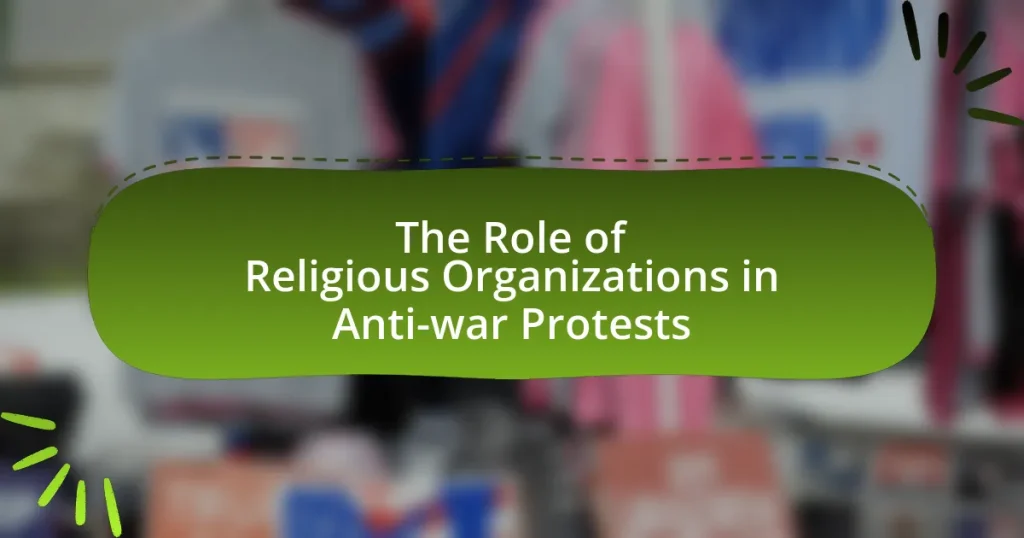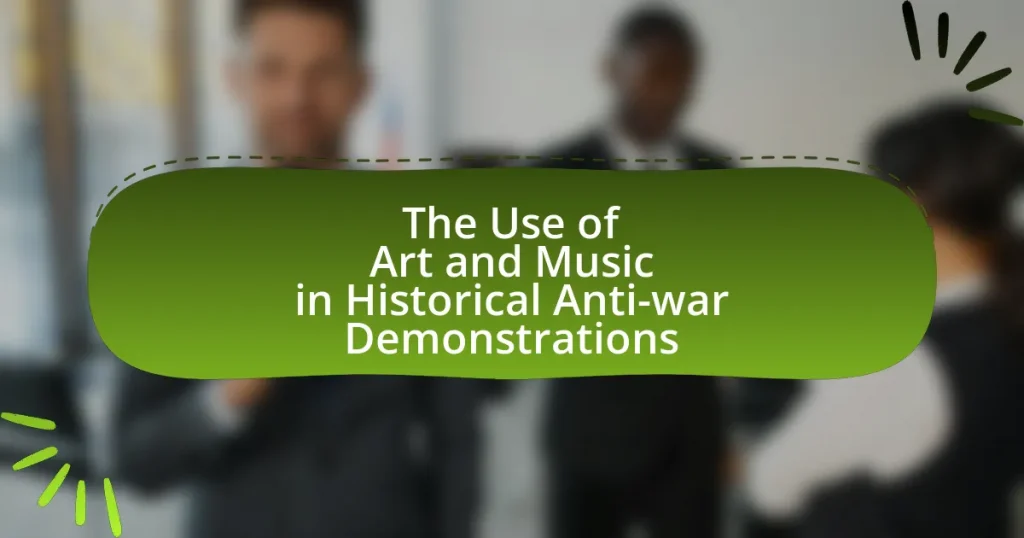The article examines the legal repercussions faced by anti-war activists throughout history, highlighting the historical contexts of anti-war movements during significant conflicts such as the Vietnam War, World War I, and World War II. It discusses how public opinion and government responses have shaped the legal landscape, including the use of laws like the Smith Act and the USA PATRIOT Act to suppress dissent. Key events that sparked protests, the evolution of laws affecting activism, and the legal challenges encountered by activists in the digital age are also analyzed. The article emphasizes the importance of historical precedents in informing current activism strategies and the ongoing legal risks associated with anti-war efforts.
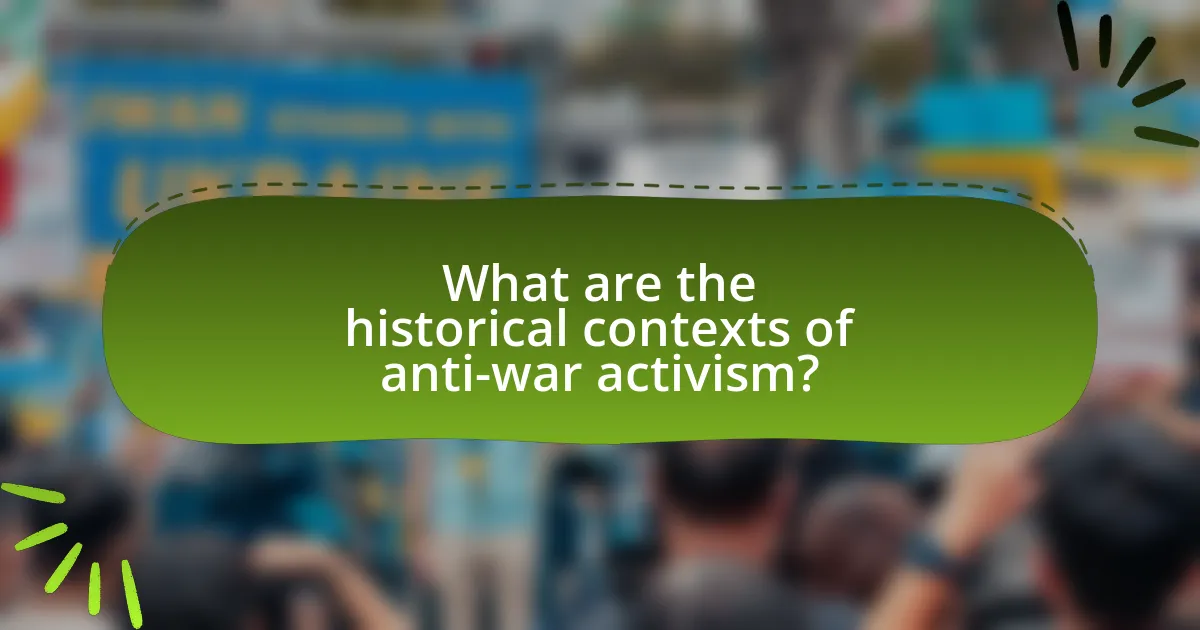
What are the historical contexts of anti-war activism?
Anti-war activism has historically emerged in response to specific conflicts and societal conditions, notably during the Vietnam War, World War I, and World War II. During the Vietnam War, widespread protests arose in the 1960s and 1970s, driven by opposition to U.S. military involvement and the moral implications of war, exemplified by events like the Kent State shootings in 1970, which galvanized public sentiment against the war. In World War I, the anti-war movement was influenced by the pacifist sentiments of groups like the Women’s Peace Party, which advocated for peace and disarmament. Similarly, during World War II, activists faced legal repercussions for their opposition, such as the Smith Act of 1940, which criminalized advocating for the violent overthrow of the government. These historical contexts illustrate how anti-war activism has been shaped by specific wars and the legal frameworks that sought to suppress dissent.
How have different wars influenced anti-war movements?
Different wars have significantly influenced anti-war movements by catalyzing public dissent and mobilizing grassroots activism. For instance, the Vietnam War sparked widespread protests in the United States during the 1960s and 1970s, leading to the formation of organizations like Students for a Democratic Society, which advocated for peace and civil rights. The Iraq War in the early 2000s similarly ignited global protests, with millions participating in demonstrations against military intervention, highlighting the role of social media in organizing and amplifying dissent. Historical data shows that anti-war movements often gain momentum in response to perceived injustices and the human cost of conflict, as seen in the protests against the Gulf War in 1991, which were fueled by reports of civilian casualties. These movements have often faced legal repercussions, such as arrests and government surveillance, reflecting the tension between state authority and civil liberties.
What specific events sparked significant anti-war protests?
The Vietnam War, particularly the Tet Offensive in 1968, sparked significant anti-war protests across the United States. This event revealed the war’s brutality and the gap between government statements and the reality on the ground, leading to widespread public disillusionment. Additionally, the Kent State shootings in 1970, where four students were killed during a protest against the invasion of Cambodia, intensified anti-war sentiments and mobilized large-scale demonstrations nationwide. These events collectively galvanized a diverse coalition of activists, students, and citizens, resulting in one of the largest anti-war movements in American history.
How did public opinion shape the legal repercussions faced by activists?
Public opinion significantly influenced the legal repercussions faced by activists, often determining the severity of legal actions taken against them. For instance, during the Vietnam War, widespread anti-war sentiment led to a more lenient approach by authorities towards protests, as public support for the activists created pressure to avoid harsh penalties. Conversely, in periods of low public support, such as during the early years of the Iraq War, activists faced stricter legal consequences, including arrests and charges of sedition, reflecting the government’s response to perceived threats to national security. Historical examples, such as the 1968 Democratic National Convention protests, illustrate how public opinion can sway legal outcomes, as the backlash against police violence during the protests led to calls for accountability and reform rather than punitive measures against the activists themselves.
What role did government responses play in shaping anti-war activism?
Government responses significantly influenced the trajectory of anti-war activism by either suppressing dissent or galvanizing public opposition. For instance, during the Vietnam War, the U.S. government employed measures such as the Smith Act and the Espionage Act to criminalize anti-war protests, which led to increased mobilization among activists who viewed these actions as violations of free speech. The violent response to protests, such as the Kent State shootings in 1970, further intensified anti-war sentiments and drew more individuals into the movement, demonstrating that government actions can provoke greater resistance and solidarity among activists.
How have laws and regulations evolved in response to anti-war protests?
Laws and regulations have evolved significantly in response to anti-war protests, often tightening restrictions on public assembly and speech. For instance, during the Vietnam War era, the U.S. government enacted measures such as the Anti-Disorder Act of 1968, which aimed to control protests through increased police powers and restrictions on demonstrations. Additionally, the introduction of laws like the Patriot Act post-9/11 further expanded governmental authority to surveil and manage dissent, reflecting a trend towards prioritizing national security over civil liberties. These changes illustrate a historical pattern where heightened anti-war sentiment has prompted legislative responses aimed at curbing protest activities.
What legal actions have been taken against anti-war activists historically?
Legal actions taken against anti-war activists historically include arrests, prosecutions, and civil lawsuits. For instance, during the Vietnam War, activists faced charges under the Smith Act of 1940, which prohibited advocating the violent overthrow of the government. High-profile cases, such as the trial of the Chicago Seven in 1969, exemplified the legal repercussions faced by anti-war demonstrators, who were charged with conspiracy and inciting riots. Additionally, the FBI’s COINTELPRO program targeted anti-war groups, employing surveillance and infiltration to disrupt their activities, leading to further legal challenges for activists. These actions illustrate the significant legal risks associated with anti-war activism throughout history.
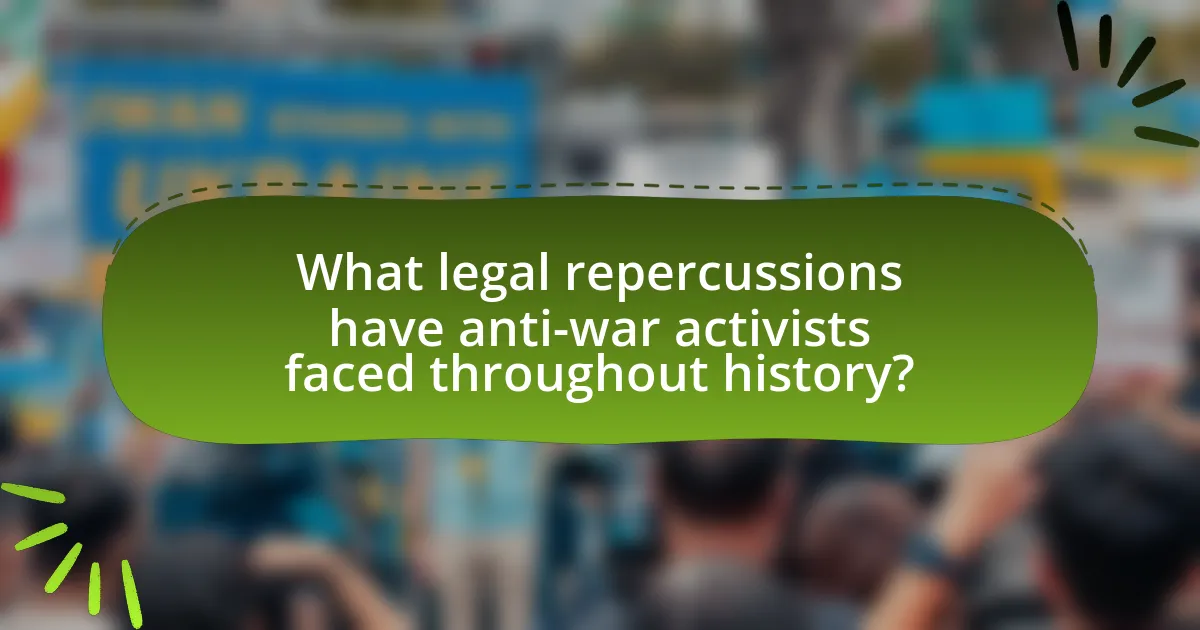
What legal repercussions have anti-war activists faced throughout history?
Anti-war activists have faced various legal repercussions throughout history, including arrest, imprisonment, fines, and restrictions on free speech. For instance, during the Vietnam War, activists like Daniel Berrigan were arrested for civil disobedience, while the Smith Act of 1940 was used to prosecute individuals for anti-war sentiments during World War II. Additionally, the USA PATRIOT Act has been employed to surveil and detain activists post-9/11, illustrating ongoing legal challenges faced by those opposing war. These examples highlight the consistent legal risks associated with anti-war activism across different historical contexts.
What types of legal consequences have been common for anti-war activists?
Anti-war activists have commonly faced legal consequences such as arrests, fines, and imprisonment. For instance, during the Vietnam War era, many activists were arrested for civil disobedience, including protests and sit-ins, leading to significant legal penalties. Additionally, laws such as the Espionage Act have been used to prosecute activists for dissenting against government policies, exemplified by cases like that of Daniel Ellsberg, who leaked the Pentagon Papers. These legal repercussions reflect a historical pattern of governmental responses to anti-war movements, often aimed at suppressing dissent.
How have charges of sedition and treason been applied to activists?
Charges of sedition and treason have been applied to activists primarily as a means to suppress dissent and discourage opposition to government policies. Historically, governments have utilized these charges against activists who challenge state authority or advocate for significant political change, particularly during times of war or national crisis. For example, during World War I, the Espionage Act of 1917 was used to prosecute anti-war activists like Eugene V. Debs, who was sentenced to ten years in prison for delivering a speech opposing the war, illustrating how sedition laws can be weaponized against political dissent. Similarly, in the 1950s, the Smith Act was employed to target members of the Communist Party, reflecting a broader pattern of using treason and sedition charges to silence activists perceived as threats to national security.
What penalties have activists faced for civil disobedience?
Activists have faced various penalties for civil disobedience, including arrest, fines, and imprisonment. For instance, during the Vietnam War protests, many activists were arrested for trespassing or obstructing traffic, leading to fines and jail time. Historical records indicate that in 1969, over 10,000 anti-war demonstrators were arrested in a single event, highlighting the legal consequences faced by those engaging in civil disobedience. Additionally, some activists have faced long-term repercussions, such as criminal records, which can affect employment and civil rights.
How have landmark cases influenced the legal landscape for anti-war activists?
Landmark cases have significantly shaped the legal landscape for anti-war activists by establishing precedents that protect their rights to free speech and assembly. For instance, the Supreme Court’s decision in Tinker v. Des Moines Independent Community School District (1969) affirmed that students do not “shed their constitutional rights to freedom of speech or expression at the schoolhouse gate,” thereby reinforcing the ability of activists to express anti-war sentiments in educational settings. Additionally, the case of Brandenburg v. Ohio (1969) set a standard that speech advocating illegal action is protected unless it incites imminent lawless action, which has provided a legal shield for anti-war protests. These rulings have collectively empowered activists by affirming their constitutional rights, thus influencing the legal framework within which they operate.
What are some significant court rulings related to anti-war activism?
Significant court rulings related to anti-war activism include the 1971 case of New York Times Co. v. United States, where the Supreme Court ruled that the government could not prevent the publication of the Pentagon Papers, affirming the First Amendment rights of the press and activists. Another notable case is the 1973 ruling in United States v. O’Brien, which upheld the government’s authority to prohibit the burning of draft cards as a form of protest, establishing a precedent for regulating symbolic speech. Additionally, the 1989 case of Texas v. Johnson affirmed the right to burn the American flag as a form of political protest under the First Amendment, reinforcing protections for anti-war activism. These rulings collectively illustrate the legal landscape surrounding anti-war protests and the balance between government authority and individual rights.
How have these rulings impacted future activism and legal standards?
These rulings have significantly shaped future activism and legal standards by establishing precedents that protect the rights of activists. For instance, landmark cases such as Tinker v. Des Moines Independent Community School District (1969) affirmed students’ rights to free speech in schools, influencing subsequent legal interpretations regarding protest rights. Additionally, rulings that limit government overreach in surveillance and protest suppression have empowered activists to challenge unjust laws, fostering a more robust legal framework for civil disobedience. The cumulative effect of these rulings has led to a more defined legal landscape that supports the rights of individuals to engage in activism without fear of excessive governmental retaliation.
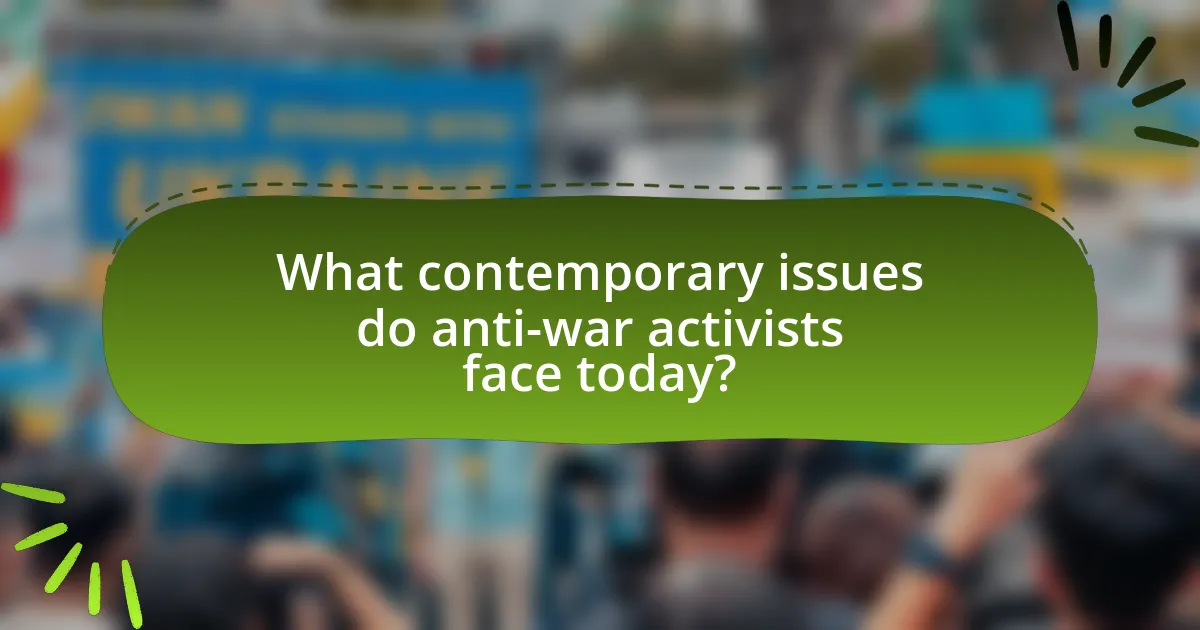
What contemporary issues do anti-war activists face today?
Anti-war activists today face significant challenges, including legal repercussions, government surveillance, and social stigma. Legal repercussions manifest through laws that restrict protests and dissent, such as anti-protest legislation enacted in various countries, which can lead to arrests and criminal charges for activists. Government surveillance has increased with advancements in technology, allowing authorities to monitor activists’ communications and activities, thereby creating a chilling effect on free expression. Additionally, social stigma arises from public perception, where anti-war activists may be labeled as unpatriotic or radical, complicating their efforts to gain broader support for their causes. These issues collectively hinder the effectiveness and safety of anti-war activism in contemporary society.
How do current laws affect modern anti-war movements?
Current laws significantly impact modern anti-war movements by imposing restrictions on protests and dissent. For instance, laws such as the USA PATRIOT Act and various local ordinances can limit the ability to assemble peacefully, often citing national security concerns. These legal frameworks can lead to increased surveillance of activists and potential criminal charges for participating in protests, as seen in cases where demonstrators have faced arrest for violating permit requirements or engaging in civil disobedience. Additionally, anti-terrorism laws can be applied to label anti-war activists as threats, which can deter participation and stifle free speech.
What legal challenges are activists encountering in the digital age?
Activists in the digital age face significant legal challenges, including issues related to surveillance, data privacy, and censorship. Governments often employ surveillance technologies to monitor online activities, which can lead to the infringement of activists’ rights to free speech and assembly. For instance, the use of laws like the USA PATRIOT Act has expanded the government’s ability to surveil individuals without warrants, impacting activists’ ability to organize and communicate securely. Additionally, activists encounter legal repercussions from social media platforms that enforce content moderation policies, which can result in the removal of posts or accounts that express dissenting views. This censorship can stifle activism and limit the reach of important messages. Furthermore, legal frameworks surrounding digital privacy, such as the General Data Protection Regulation (GDPR) in Europe, create complexities for activists who must navigate compliance while advocating for change. These challenges highlight the precarious balance between activism and legal constraints in the digital landscape.
How do anti-terrorism laws impact anti-war activism?
Anti-terrorism laws significantly restrict anti-war activism by criminalizing dissent and labeling activists as potential threats. These laws often empower law enforcement to surveil, detain, or prosecute individuals involved in anti-war protests under the guise of national security. For instance, the USA PATRIOT Act, enacted after the September 11 attacks, expanded the government’s ability to monitor and investigate individuals and groups, leading to increased scrutiny of anti-war organizations. This legal framework creates a chilling effect, discouraging participation in protests due to fear of legal repercussions, thereby stifling free expression and assembly rights.
What strategies can anti-war activists employ to navigate legal challenges?
Anti-war activists can employ strategies such as legal education, coalition building, and strategic litigation to navigate legal challenges. Legal education equips activists with knowledge about their rights and the legal system, enabling them to better understand the implications of their actions. Coalition building with other organizations can amplify their voice and provide legal resources, as seen in movements like the Vietnam War protests where groups collaborated to share legal expertise. Strategic litigation involves using the courts to challenge unjust laws or practices, which has historically led to significant legal precedents that protect activists’ rights, such as the Supreme Court’s ruling in Tinker v. Des Moines Independent Community School District, which affirmed students’ rights to free speech in schools.
How can activists effectively advocate for their rights within the legal system?
Activists can effectively advocate for their rights within the legal system by utilizing legal frameworks, engaging in strategic litigation, and mobilizing public support. Legal frameworks, such as constitutional rights and international human rights laws, provide a basis for activists to challenge unjust laws and practices. Strategic litigation involves selecting cases that can set legal precedents, thereby influencing future legal interpretations and policies. For instance, the landmark case of Brown v. Board of Education in the United States demonstrated how strategic litigation can dismantle systemic discrimination. Additionally, mobilizing public support through campaigns and awareness initiatives can amplify activists’ voices, pressuring legal institutions to uphold rights. Historical examples, such as the Civil Rights Movement, illustrate how collective action and legal advocacy can lead to significant legal reforms.
What resources are available for legal support for anti-war activists?
Legal support resources for anti-war activists include organizations such as the National Lawyers Guild, which provides legal assistance and representation for activists facing charges related to their protests. Additionally, the American Civil Liberties Union offers legal support and advocacy for civil rights, including those of anti-war demonstrators. Furthermore, local legal aid societies often assist activists with legal issues arising from their participation in protests. These organizations have a history of defending the rights of activists, ensuring they receive fair treatment under the law.
What lessons can be learned from the history of anti-war activism?
The history of anti-war activism teaches that sustained public dissent can influence government policy and public opinion. For instance, the Vietnam War protests in the 1960s and 1970s significantly swayed American public sentiment against the war, leading to policy changes and the eventual withdrawal of U.S. troops. Additionally, anti-war activists often face legal repercussions, such as arrests and censorship, which highlight the tension between civil liberties and national security. The experiences of activists during the Vietnam War, including the use of the Smith Act to suppress dissent, illustrate the risks involved in challenging government actions. These historical examples underscore the importance of resilience and organization in advocacy efforts, as well as the need for legal protections for activists to ensure their voices can be heard without fear of reprisal.
How can historical precedents inform current activism strategies?
Historical precedents can inform current activism strategies by providing insights into effective methods of mobilization and the legal challenges activists may face. For instance, the anti-war movements of the 1960s, particularly those opposing the Vietnam War, demonstrated the power of mass protests and civil disobedience, which led to significant public discourse and policy changes. Additionally, legal cases such as Tinker v. Des Moines Independent Community School District (1969) established the right to free speech in schools, influencing how activists today approach legal protections for their actions. By analyzing these historical examples, current activists can adapt strategies that have proven successful while remaining aware of potential legal repercussions, thereby enhancing their effectiveness in advocating for change.
What best practices can activists adopt to minimize legal repercussions?
Activists can minimize legal repercussions by adhering to established legal guidelines, documenting their actions, and engaging in peaceful protest methods. Following local laws and regulations ensures that activists do not inadvertently violate statutes, which can lead to arrests or charges. Documenting actions, including gathering evidence of peaceful intent and maintaining records of communications, can provide legal protection and support claims of lawful behavior. Engaging in peaceful protest methods, such as sit-ins or marches that do not disrupt public order, reduces the likelihood of confrontations with law enforcement. Historical examples, such as the civil rights movement, demonstrate that adherence to nonviolent principles and legal frameworks can effectively mitigate legal risks while advancing social causes.

